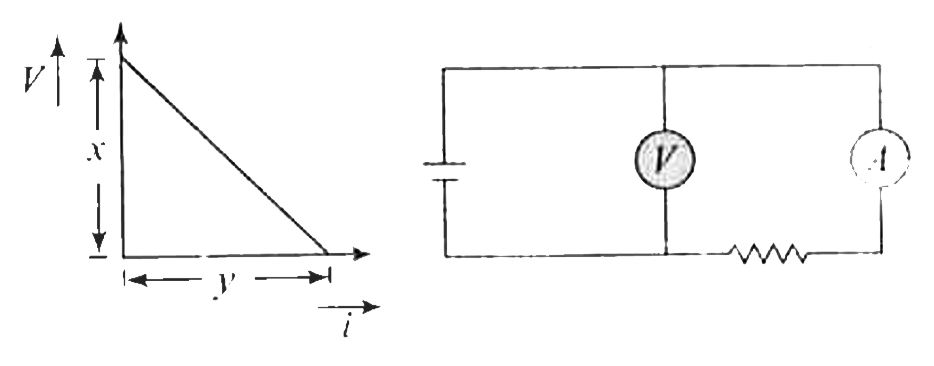A student measurres the terminal potential difference (V) of a cell (of emf ∈ and internal resistancer) as a function of the current (I) flowing through it.The slope, and intercept, of the graph between V and I, then, respectively, equal:Solution in Tamil
-r and ∈
r and -∈
-∈ and r
∈ and -r
Step by step video & image solution for A student measurres the terminal potential difference (V) of a cell (of emf in and internal resistancer) as a function of the current (I) flowing through it.The slope, and intercept, of the graph between V and I, then, respectively, equal: by Physics experts to help you in doubts & scoring excellent marks in Class 12 exams.
Updated on:21/07/2023Topper's Solved these Questions
Similar Questions
Nickel shows ferromagnetic property at room temperature. If the temperature is increased beryond Curie temperatue,then it will show
View SolutionThe work function of a surface of a photosensitive material 6.2eV . The wavelength of the incident radiation for which the stopping potentials is 5V lies in the:
View SolutionFor a cell, a graph is plotted between the potential difference V across the terminals of the cell and the current I drawn the cell. The emf and the internal resistance of the cell are E and r, respectively. Then
View SolutionA student measures the terminal potential difference (V) of a cell (of emf epsilon and internal resistance r ) as a function of the current (I) flowing through it. The slope and intercept of the graph between V and I , then respectively, equal
View SolutionIn an experiment, a graph was plotted of the potential difference V between the terminals of a cell against the circuit current i by varying load rheostat. Internal conductance of the cell is given by

View SolutionIn an experiment, a graph was plotted of the potential difference V between the terminals of a cell against the circuit current "I" by varying load rheostat, internal conductance of the cell is given by

View SolutionA student measures the terminal potential difference (V) of a cell (of emf ε and internal resistance r) as a function of the current (I) flowing through it. The slope and intercept of the graph between V and I, then respectively, equal
View Solutionएक विद्यार्थी एक सेल (विद्युत वाहक बल तथा आन्तरिक प्रतिरोध r) का टर्मिनल विभवान्तर (V) का मापन करता है। टर्मिनल विभवान्तर, सेल से बहने वाली धारा (I) का फलन है। V−I ग्राफ की प्रवणता तथा कटान, क्रमशः हैं
View SolutionThe variation of terminal potential difference (V) with current flowing through a cell is as shown. The emf and internal resistance of the cell are

View SolutionThe potential difference V is proportional to the current I, the graph between V and I is a . . . . .. . . . . .
View Solutionएक छात्र एक सेल (जिसका वि. वा. बल. (emf) है ओर आन्तरिक प्रतिरोध r है) के टर्मिनलों के विभवांतर (V) के सेल में चल रही धारा (I) से संबंध जानने के लिये V और I के बीच ग्राफ बनाता है। इस ग्राफ की प्रवणता और अंतः खण्ड क्रमानुसार होंगे
View SolutionThe diagram besides shows a circuit used in an experiment to determine the emf and internal resistance of the cell C. A graph was plotted of the potential difference V between the terminals of the cell against the current I, which was varied by adjusting the rheostat. The graph is shown on the right , x and y are the intercepts of the graph with the axes as shown. What is the internal resistance of the cell ?

View Solutionएक छात्र एक सेल (जिसका वि. वा. बल. (emf) है ओर आन्तरिक प्रतिरोध r है) के टर्मिनलों के विभवांतर (V) के सेल में चल रही धारा (I) से संबंध जानने के लिये V और I के बीच ग्राफ बनाता है। इस ग्राफ की प्रवणता और अंतः खण्ड क्रमानुसार होंगे
View SolutionThe variation of terminal potential difference (V) with current flowing through a cell is as shown The emf and internal resistance of the cell are
View SolutionIn an experiment, a graph was plotted of the potential difference V between the terminals of a cell against the circuit current "I" by varying load rheostat, internal conductance of the cell is given by
View SolutionA student measures the terminal potential difference (V) of a cell (of emf ε and internal resistance r) as a function of the current (I) flowing through it. The slope and intercept of the graph between V and I, then respectively, equal
View Solution
